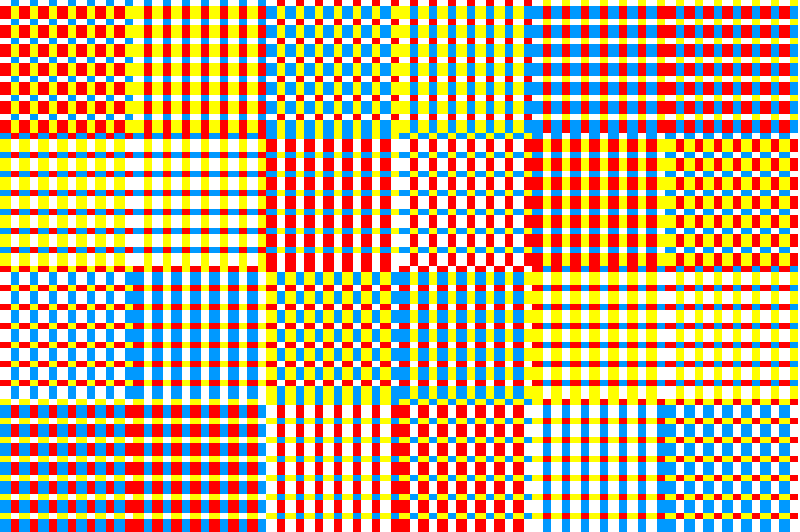Experiment with colours and proportion
Top-Slider
vertical proportion adjustment
Bottom-Slider
horizontal proportion adjustment
Buttons C1..C4
repeatedly click to change colors 1 to 4
The geometry of the 24 square fields in Spot 04 is identical: it consists of 36 repeated quadratic modules that are composed of four coloured rectangular elements. The proportions of these rectangles can be modified interactively in the same way as in Spot 01. The four colours that can be chosen may be allocated in precisely 24 different ways. As a result of this, 24 different fields can be generated and shown in 4 lines and 6 columns.
A physical eye could only see the four interactively selected colours in the entire picture. The human eye, however, perceives a wealth of colour shades. The first reason for this complex colour illusion, which we call the Bezold*) effect, is the way in which the surface is divided up inside the module. A second reason is the juxtaposition of colours within the module. The blelb team has already tried in earlier publications to separate these two influences (see «Blue. Yellow. Red.» by Hans Knuchel and Jürg Nänni). Spot 08 focuses on one aspect of Spot 04: the juxtaposition of colours is kept constant in order to allow the effects of changes in the proportions of the elements to be observed separately. In Spot 08, only the length and width of the elements is reversed. The explanations given for Spot 08 contain an additional interactive experiment: the influence of the module's geometry is suppressed by means of 4 square elements and the juxtaposition of colours is modified. This enables the effect of the second cause mentioned above to be observed as well.

The test picture shows various shades of white, blue, red and yellow, which are created by the surface layout of the basic module which is constant throughout the image and by the juxtaposition of colours within one field. The changes in colour are especially striking when contrasting colours are used and there are marked differences.
The change in this colour is sharply reduced in comparison with the other colours used. This means that green is relatively constant in its hue, that is to say: more resistant than other colours to the influences of blue, yellow and red. We all know that green is in the centre of the visible spectrum and that the human eye demonstrates its highest receptor sensitivity in this range. The wavelength distances from the other colours chosen are minimised and might well have something to do with green being so stable. [This resistance could however also be a positive evolutionary development of our herbivorous ancestors who may have improved their chances of survival by clearly identifying the products of photosynthesis they needed to live. With changes in natural light, with a blue, yellow and red cast, the fact that the colour green remains constant can be an advantage.]
An analogy can be drawn to music by speaking of the various harmonies of the 24 fields. The four basic colours chosen correspond to the frequencies of four tones. The surface proportion of a colour element corresponds to the volume of the tone in question. The interaction and interference of «adjacent» tones change the perception of the individual tones and produce a complicated integral sound with unusual, apparent adjustments in frequency. Similar illusions have been notices in connection with the «so-called» perfect sound of orchestras.
An attractive elementary illustration showing the Bezold effect*) can be found in the appendix to Spot 01 see test images 19 and 20).
*) Prof. Wilhelm von Bezold published a comprehensive study of colours in 1874. He had nothing in fact to do with the colour effect named after him, he might not even have recognised it. In his book, Bezold primarily focuses on simultaneous contrast and illusions occurring from experimenting with light and shade. In a practically oriented chapter, Bezold attempts to make his findings accessible to the textile industry and the world of art. The Bezold illusion is not thought to have been discovered until the 20th century.